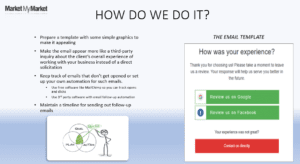Among the specific marketing campaigns Market My Market has been doing for clients for two years now, Quality Review Generation has been at the forefront of importance for numerous reasons. You’ll learn that consumers find reviews to be extremely important because of:
- How much of an impact positive, quality reviews are having on the decision-making of consumers
- How much emphasis directories and search engines have placed on the visibility of businesses with quality reviews, likely perpetuated over the years indirectly and directly by Yelp and Google
- Email Template Doesn’t Have Appropriate Links for Clientele
There may be a sizeable portion of consumers who are left out of the pool of potential reviews for different reasons. They may include consumers like the elderly or those who are beyond the point of technological savviness or maintaining a regular email account. Some companies engage with clientele that may not have consistent access to the internet or email, making it nearly impossible for these clients to leave a review online.
- Email Template Design is Poor
Our most successful email campaigns made use of quality design, partially to elevate the email to a standard of professionalism, but also because a well-formatted email provokes a positive initial reaction from the client and guides him or her to more easily move along the review process. This contrasts with simpler email templates, such as those which only allow for a few blocks of texts and some hyperlinks.
- There is No Plan for Follow-Ups and/or Automation
Standing at number three may be the most common reason review generation never works for businesses – there are no follow-ups. Think about any solicitation you’ve gotten – even if the subject line was meaningful and the content was helpful, it still could have taken a few follow-ups for you to say, “what the heck” and finally connect with the sender. Even when you already have a connection with the former client, this type of scenario is still common.
The general consumer, especially after working with a vendor or business, can be dismissive, passive, and forgetful regardless of how good of an experience they had. Sometimes it just takes being a bit more proactive with follow-ups before it clicks for them and they finally set aside the several minutes it takes to complete one or a few reviews.
Finding a way to remind yourself or your associates to follow-up is easy; however, creating a system to automate it is not as easy. One of the more straightforward ways you may be able to accomplish this is using a current e-mail platform you already use, such as a MailChimp or Constant Contact. You can place your former clients on an email journey to receive the same email 3-6 times. Should they eventually respond during that journey, you can log into MailChimp to make sure they don’t receive additional emails.
- Emails Sound too Much Like Solicitations
From our research and experimentation, we’ve had much more success when emails were coming from an email that was more like customerexperience@company.com or feedback@company.com instead of directly from an employee or someone that seemed like they were asking for a review instead of honest feedback. Though the best end goal of this effort is a review, it should always start as an honest request for feedback about the customer’s experience. We have had even more success when the email being sent is from another domain or company altogether, truly solidifying the fact that the business seeks neutral third-party feedback from the former client.
- There is no “Drip” Approach to Sending Out Emails
There is a clear reason drip marketing is being employed to the extent it is today – it is almost scientific. Drip marketing prevents your email server from being overloaded should you decide that sending out thousands of emails at once is the way to go. It also makes an influx of positive reviews look less suspicious; if you generate 100 positive reviews on Google in one day, there’s nearly no way the majority will stick, regardless of them coming from dozens of legitimate, original IPs and email accounts. The train of thought is that there was a massive solicitation campaign for these reviews, which is why many will eventually disappear. With a drip approach, former customers receive review requests over a period of time.
- The Content of the E-Mail Follow Up Doesn’t Work
I don’t use the acronym KISS often, mostly because I don’t like it, but it is appropriate here. KISS stands for “Keep it Simple, Stupid.” The emails companies send to solicit reviews don’t have to go into a whole explanation about how feedback and reviews make the world go ‘round and would mean the world to them and their employees. When writing these emails, keep them brief and to the point. A suggestion is to lead into the email with a question, like “How Was Your Experience?” and then write 2-3 sentences explaining how the feedback you receive would help.
- Emails Aren’t Sent at the Right Time of the Day or Week
Is this common sense…or not? Sending emails at a certain time of the day or week makes a big difference! Avoid weekends and wee hours of the night. Based on our research, the best time to send emails is typically on Tuesdays and Thursdays between 10 AM and 2 PM.
- Attempting to Get Reviews at the Place of Business
We’re all guilty of it, especially me. As an in-house Director of Marketing for several years, one of my “genius” ideas was to have clients or former clients sit in front of an iPad or laptop set up completely for reviews with all the quick links they’ll need to log into different accounts and leave numerous reviews. Years later and countless accounts of many other brainiacs doing the same, we’ve all concluded that this approach doesn’t work. Why? Typically, one of two reasons (or both):
- The client is creating an email or an account to use for the first time, within minutes, to leave a review. This is easily tracked by websites and once that account leaves the review and has no other activity, it is obvious that it was just for that lone review. These reviews typically don’t stick.
- The review is logged by its IP address, which would be in simple terms the identification for the location of that business’s internet provider. Multiple reviews with the same tagged IP address origination are typically removed.
While the whole “We’ve got them here! Have them leave a review!” mentality makes sense to me, it comes off too much as a solicitation.
- Companies Haven’t Attempted to Create a Mailing List in the First Place
Do you ever get your clients’ email addresses during your first meeting? Creating a database for emails not only pays off for e-newsletters, but it is also pivotal in review correspondences such as the review generation process we’ve been discussing this entire time! Whether you have emails in contact forms, as part of a loyalty program or invoicing, make sure you can always associate a client or customer with an email address.
- Companies Aren’t Providing a Quality Product or Service
In some instances, we must take a step back and realize maybe we aren’t getting all the raving reviews we’re looking for because the product or service being provided needs improvement!
What’s Your Reason?
Not getting the reviews you think you deserve? At Market My Market, our team of digital marketing experts can implement review generation strategies to help you reach out to past clients so that you can start seeing the reviews you’ve always wanted. We strive to help you develop and cement your online credibility, and a review generation strategy is just one of the many ways we can accomplish this together. Contact us for a free marketing consultation.

The ongoing digital revolution is transforming the way that all businesses interact with clients and customers. Consumers rely heavily on digital channels for researching products and services and expect to make buying choices with the swipe of a finger. For organizations that want to remain competitive, having a defined digital marketing strategy and execution plan is essential for successful outcomes. With a demonstrated history of creating and implementing strategic digital marketing initiatives that drive growth, I am committed to delivering real, measurable results for my clients.



